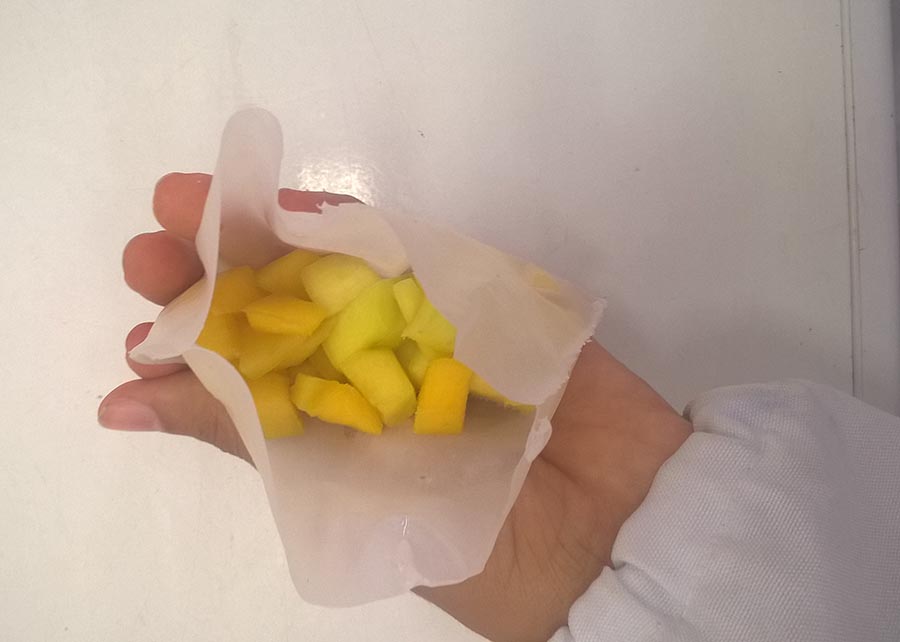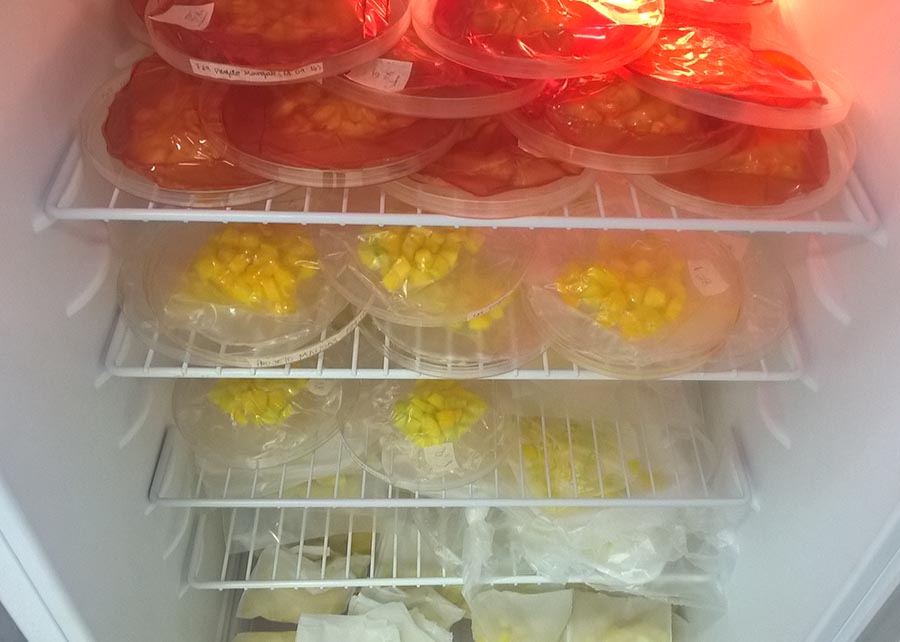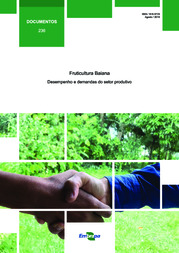The technology uses coconut fiber, a residue from the fruit processing, which adds value to the chain and improves sustainability. The packaging is aimed at minimally processed fruits: cut, rindless and pitted mangoes. The polymer mix it is made of decomposes in less than six months after it is thrown away. The solution could be applied to other fruits. The work is one of the results of GestFrut, a project by Embrapa to support fruit farming in the state of Bahia. Scientists await partnerships with the production sector to bring the new product to the market. A new type of biodegradable packaging for mango exports is among the technological solutions generated by the GestFrut project, which is coordinated by Embrapa Cassava and Fruits. Designed for freshly cut (minimally processed: rindless and pitless) mangoes, the new packaging is more sustainable and adds value by using domestic raw materials. It was developed in the National Service of Industrial Training's Integrated Campus of Manufacturing and Technology (Senai-Cimatec), one of Embrapa's partners in GestFrut. The authors look for partners in the production sector to conclude the development of the solution and take it to the market. The product is composed of cellulose nanocristals that provide higher resistance to the packaging. The researchers used a mix of two polymers, which is called a polymer blend. The substance is fully biodegradable and its formula includes cassava starch and coconut fiber, typical Brazilian products. According to the Senai researcher and project leader Bruna Machado, the differential of the packaging lies precisely in its composition. “We use cellulose nanocristals from a source that we call residue or waste, coconut fiber, which is underexploited. Moreover, it is a low-cost raw material that is abundantly found in the [Brazilian] Northeast. And another one of our sources that is of equally cheap and easy access is cassava, which adds regional value to the product”, she stresses. The researcher reports that the process of developing the packaging also considered other issues for the current market, such as consumer demand for a practical and healthy diet and the optimization of the product for exports. “Bahia is a large mango producer, especially the São Francisco river valley and the southwest of the state, in the towns of Dom Basílio and Livramento de Nossa Senhora. The minimally processed fruits have great appeal for exports,” the scientist remarks. She says that containers full of mangoes are taken abroad and, once they get there, their rinds and pits are removed and the fruit is cut for immediate consumption. “Then why not do this in Brazil and export it already prepared? And why not in a biodegradable packaging? These were several problems that we wanted to solve”, Machado recalls. She underscores that the technology complied with the determinations of the Brazilian Association of Technical Standards (ABNT) or biodegradable products, which stipulate the decomposition of organic waste in up to six months. The goal is to extend this solution to other fruits. “As it is an innovation project, we made some adjustments in the technological routes that had been initially established, and we had the fundamental support of the Federal University of Bahia (UFBA) Pharmacy College to develop the packaging through an extrusion process at a smaller scale”, she adds. Now the team has obtained a functional prototype at an industrial scale, but it is necessary to expand scalability and to make improvements to the formulas so that it can reach the market. For the GestFrut coordinator and Embrapa researcher Domingo Haroldo Reinhardt, the packaging is an interesting technological asset. “It meets the current demands for environmentally sound products, as it is biodegradable, uses residue, and contributes to the convenient consumption of ready-to-eat fruit, reducing waste. With such advantages, it has good prospects of economic viability, and can attract partners from the private sector to conclude the process of innovation”, he states.
-
The technology uses coconut fiber, a residue from the fruit processing, which adds value to the chain and improves sustainability. -
The packaging is aimed at minimally processed fruits: cut, rindless and pitted mangoes. -
The polymer mix it is made of decomposes in less than six months after it is thrown away. -
The solution could be applied to other fruits. -
The work is one of the results of GestFrut, a project by Embrapa to support fruit farming in the state of Bahia. -
Scientists await partnerships with the production sector to bring the new product to the market. |
A new type of biodegradable packaging for mango exports is among the technological solutions generated by the GestFrut project, which is coordinated by Embrapa Cassava and Fruits. Designed for freshly cut (minimally processed: rindless and pitless) mangoes, the new packaging is more sustainable and adds value by using domestic raw materials. It was developed in the National Service of Industrial Training's Integrated Campus of Manufacturing and Technology (Senai-Cimatec), one of Embrapa's partners in GestFrut. The authors look for partners in the production sector to conclude the development of the solution and take it to the market.
The product is composed of cellulose nanocristals that provide higher resistance to the packaging. The researchers used a mix of two polymers, which is called a polymer blend. The substance is fully biodegradable and its formula includes cassava starch and coconut fiber, typical Brazilian products.
According to the Senai researcher and project leader Bruna Machado, the differential of the packaging lies precisely in its composition. “We use cellulose nanocristals from a source that we call residue or waste, coconut fiber, which is underexploited. Moreover, it is a low-cost raw material that is abundantly found in the [Brazilian] Northeast. And another one of our sources that is of equally cheap and easy access is cassava, which adds regional value to the product”, she stresses.
The researcher reports that the process of developing the packaging also considered other issues for the current market, such as consumer demand for a practical and healthy diet and the optimization of the product for exports. “Bahia is a large mango producer, especially the São Francisco river valley and the southwest of the state, in the towns of Dom Basílio and Livramento de Nossa Senhora. The minimally processed fruits have great appeal for exports,” the scientist remarks.

She says that containers full of mangoes are taken abroad and, once they get there, their rinds and pits are removed and the fruit is cut for immediate consumption. “Then why not do this in Brazil and export it already prepared? And why not in a biodegradable packaging? These were several problems that we wanted to solve”, Machado recalls.
 She underscores that the technology complied with the determinations of the Brazilian Association of Technical Standards (ABNT) or biodegradable products, which stipulate the decomposition of organic waste in up to six months.
She underscores that the technology complied with the determinations of the Brazilian Association of Technical Standards (ABNT) or biodegradable products, which stipulate the decomposition of organic waste in up to six months.
The goal is to extend this solution to other fruits. “As it is an innovation project, we made some adjustments in the technological routes that had been initially established, and we had the fundamental support of the Federal University of Bahia (UFBA) Pharmacy College to develop the packaging through an extrusion process at a smaller scale”, she adds. Now the team has obtained a functional prototype at an industrial scale, but it is necessary to expand scalability and to make improvements to the formulas so that it can reach the market.
For the GestFrut coordinator and Embrapa researcher Domingo Haroldo Reinhardt, the packaging is an interesting technological asset. “It meets the current demands for environmentally sound products, as it is biodegradable, uses residue, and contributes to the convenient consumption of ready-to-eat fruit, reducing waste. With such advantages, it has good prospects of economic viability, and can attract partners from the private sector to conclude the process of innovation”, he states.

She underscores that the technology complied with the determinations of the Brazilian Association of Technical Standards (ABNT) or biodegradable products, which stipulate the decomposition of organic waste in up to six months.

